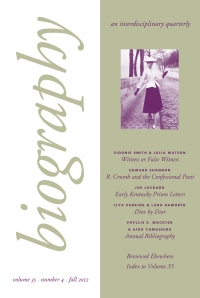ARTICLES
In Remembrance: Dr. Julia Swindells
Margaretta Jolly, 587
Witness or False Witness: Metrics of Authenticity, Collective I-Formations, and the Ethic of Verification in First-Person Testimony
Sidonie Smith and Julia Watson, 590
One possible response to allegations of hoaxing that surround the contemporary traffic in witness narratives is to re-theorize issues central to testimonial narration. Rather than arguing that the truth or falsity of witness narratives can be definitively determined, we complicate the transparency of the first-person narrator in testimony and the claim of authenticity that has become the guarantor of that subject position. To do so, we explore how the effect of authenticity is produced by certain “metrics,” and how differing “I”-formations—here, composite, coalitional, translated, and negotiated—generate the aura of authenticity a text projects, as well as the imagined relation of readers to personal stories of witness. After tracking the metrics of authenticity in four exemplary texts—“Souad”’s Burned Alive, the Sangtin Collective’s Playing with Fire, Ishmael Beah’s A Long Way Gone, and Dave Eggers’s What is the What?—we suggest an alternative reading practice to “rescue” the reading often associated with testimonial narratives.
Shameful, Impure Art: Robert Crumb’s Autobiographical Comics and the Confessional Poets
Edward Shannon, 627
Cartoonist Robert Crumb’s work echoes confessional poetry. Crumb, John Berryman, and Sylvia Plath metaphorically adopt the personae of oppressed minority figures. Along with this identification with the oppressed other, Crumb and Plath exhibit a curious and disquieting relationship with power and oppression.
“No Possessions but Rages”: Vindication, Salvation, and Early Kentucky Prison Letters
Joe Lockard, 650
Testimonies of salvation, popular in contemporary faith-based prison programming, have a lengthy history in US prison literature. Yet accounts of private spirituality can as easily frame an epistemic insufficiency of topical avoidance, concealment, and falsification. To illustrate the pitfalls of such narratives the paper historicizes and analyzes the unpublished 1793–94 prison letters of John Shaw, held in a Kentucky jail for seven years on unknown grounds. By claiming a divine mantle in his letters, Shaw avoids confronting himself. While he writes that he has laid his “soul naked” before readers, in fact he does the opposite and obscures himself. This double motion—both to participate in the world and to hide from it—relies on fabulation and a vindication narrative based on Christian faith.
The Public Time of Private Space in Dior by Dior
Ilya Parkins and Lara Haworth, 668
This essay reads the life writing of major French fashion designer Christian Dior as an extended meditation on the challenging relationship between public persona and intimate selfhood for a celebrity fashion designer. Dior works through the tension between public and private by referring it to a complex nexus of space and time; his narration of his life through the lens of his childhood homes suggests not only a spatial orientation but a fraught relationship to the past. Dior’s characteristic reflections on space and time reveal him to be a nostalgic subject, but by theorizing nostalgia as a creative mnemonic mode, we challenge understandings of him as excessively conservative in his tastes and designs. Ultimately, Dior’s constellation of space and time points to new methodological tools for understanding fashion designers and their celebrity.
Annual Bibliography of Works about Life Writing, 2011–2012
Phyllis E. Wachter and Aiko Yamashiro, 690
REVIEWED ELSEWHERE
Excerpts from recent reviews of biographies, autobiographies, and other works of interest, 834
CONTRIBUTORS, 878





